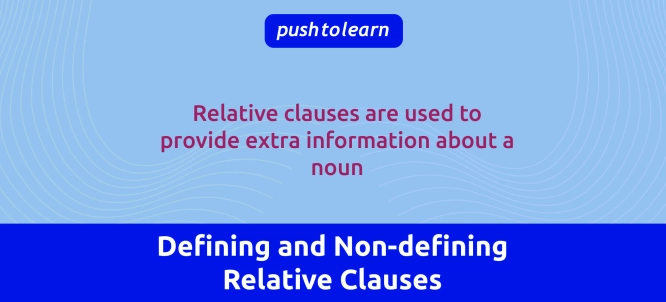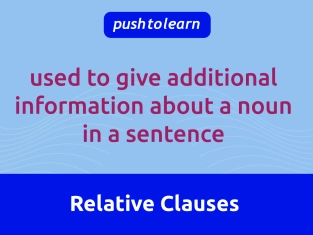by PushtoLearn
Defining and Non-defining Relative Clauses
Table of Contents
Defining and Non-defining Relative Clauses – Exercises
These exercises focus on Defining and Non-defining Relative Clauses
What Are Relative Clauses?
Relative clauses are parts of a sentence that begin with relative pronouns like who, which, that, whose, where, or when. They describe or give more information about a noun in the sentence.
Examples:
-
The woman who lives next door is a doctor.
-
My car, which is red, is parked outside.

Defining Relative Clauses
A defining relative clause gives essential information about the noun it describes. Without this information, the sentence would lose its meaning.
Key Features:
-
No commas are used.
-
Uses who, which, that, whose, where, or when.
Examples:
-
The book that I borrowed from you is amazing.
-
The man who fixed my car did a great job.
Structure:
Main clause + relative pronoun + defining clause
|
Relative Pronoun |
Use |
Example |
|
Who |
For people |
The teacher who helped me is kind. |
|
Which |
For things or animals |
The movie which I saw yesterday was great. |
|
That |
For people, things, or animals (informal) |
The car that he bought is expensive. |
|
Whose |
To show possession |
The boy whose dog is lost is crying. |
|
Where |
For places |
The city where I grew up is beautiful. |
|
When |
For times |
The day when we met was unforgettable. |
Non-defining Relative Clauses
A non-defining relative clause adds extra, non-essential information about a noun. The sentence would still make sense without this clause.
Key Features:
-
Commas are used to separate the clause.
-
Does not use "that."
-
Commonly uses who, which, whose, where, or when.
Examples:
-
My brother, who lives in New York, is visiting us next week.
-
The Eiffel Tower, which is in Paris, is a famous landmark.
Structure:
Main clause, + relative pronoun + non-defining clause, + rest of the sentence
Comparison of Defining and Non-defining Clauses
|
Feature |
Defining Relative Clause |
Non-defining Relative Clause |
|
Importance |
Essential to the sentence’s meaning |
Extra information, not essential |
|
Punctuation |
No commas |
Commas separate the clause |
|
Use of "that" |
Can use "that" |
Cannot use "that" |
|
Example (Person) |
The girl who is wearing red is my friend. |
My friend, who is wearing red, is here. |
|
Example (Thing) |
I bought the house that has a garden. |
The house, which has a garden, is beautiful. |
Common Errors
-
Misusing commas
-
Incorrect: The teacher, who helped me, is kind. (not extra information)
-
Correct: The teacher who helped me is kind.
-
Using "that" in non-defining clauses
-
Incorrect: My laptop, that is new, is very fast.
-
Correct: My laptop, which is new, is very fast.
-
Confusing defining and non-defining clauses
-
Incorrect: The car, that he drives, is blue. (essential information, no commas)
-
Correct: The car that he drives is blue.
-
Forgetting the relative pronoun
-
Incorrect: The book I read yesterday is excellent.
-
Correct: The book that I read yesterday is excellent. (This is acceptable in informal contexts, but be cautious in formal writing.)
See also Wich vs Which
Everyday Uses
Defining Clauses
-
At Work: "The colleague who helped me with the report deserves credit."
-
At Home: "The recipe that you shared was delicious."
Non-defining Clauses
-
At Work: "The CEO, who has 20 years of experience, is giving a speech."
-
At Home: "My mother, whose cooking is amazing, made dinner."
FAQ
What are defining relative clauses?
Defining relative clauses provide essential information about a noun. Without them, the sentence’s meaning changes.
What are non-defining relative clauses?
Non-defining relative clauses add extra, non-essential information. They are separated by commas.
Can I use "that" in non-defining relative clauses?
No, "that" is only used in defining relative clauses. Use "who" or "which" for non-defining clauses.
What is the difference between "which" and "that"?
"Which" is used for both defining and non-defining clauses. "That" is only used in defining clauses and cannot be used with commas.
How can I avoid common errors with relative clauses?
Pay attention to whether the information is essential (defining, no commas) or extra (non-defining, with commas).

